The intricate dynamics of the relationship between dogs and children have been the subject of a recent study, revealing a fascinating level of responsiveness and synchrony exhibited by dogs towards their young human counterparts. This movement mimicry between dogs and kids not only strengthens their bond but also brings about a myriad of benefits for the children involved.
From bolstering emotional well-being to encouraging physical activity, the profound impact of this connection extends far beyond mere companionship. As we unravel the depths of this unique relationship, it becomes evident that there is much more to discover about the profound connection between our canine companions and the little ones in our lives.
Key Takeaways
- Dogs are highly responsive and sync with kids' movements, enhancing their bond.
- Kids benefit from growing up with dogs, reducing loneliness and boosting self-esteem.
- Encouraging kids to care for dogs strengthens the child-dog relationship significantly.
- Dogs can learn from kids, showcasing the bond's depth and mutual understanding.
Study Findings on Dogs and Kids Relationship
In a comprehensive study assessing the relationship between dogs and children, researchers found that dogs exhibit a remarkable level of responsiveness by matching kids' movements approximately 60% of the time, indicating a strong connection between the two. This movement mimicry is a significant factor in strengthening the bond between kids and dogs.
Furthermore, growing up with a dog has been shown to relieve loneliness, boost children's self-esteem, and encourage them to be more active. The study highlights the unique ability of dogs to synchronize their behavior with children, showcasing the potential benefits of this relationship on the well-being and development of both parties involved.
Benefits of Kids Taking Care of Dogs
Taking on pet care duties enhances the relationship between children and dogs by fostering a sense of responsibility and strengthening the bond between the two. When kids actively participate in the care of a family dog, such as feeding, grooming, and walking, they develop a deeper connection with the pet.
Strengthening Child-Dog Relationship
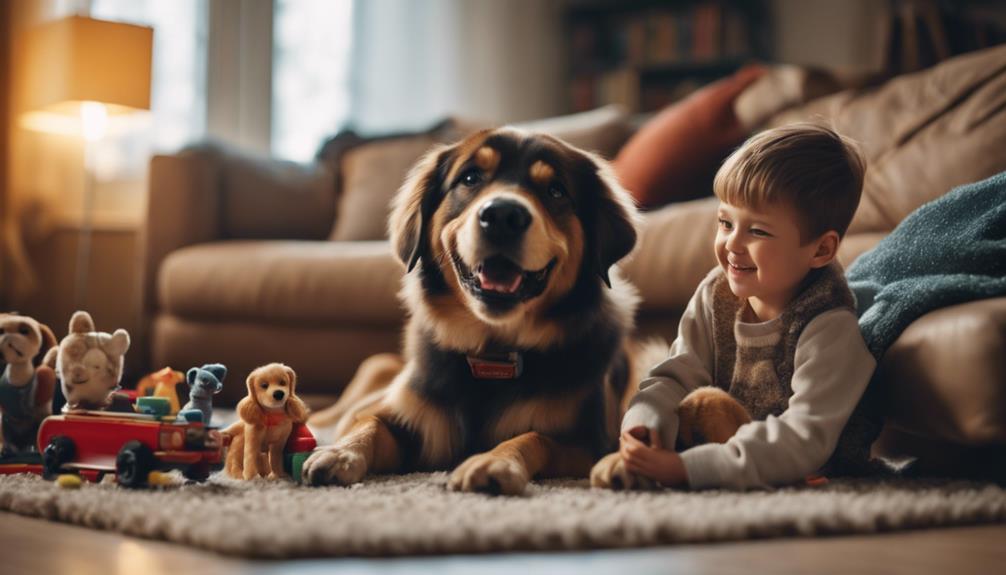
To enhance the bond between children and dogs, active participation in pet care duties is essential for fostering a strong and lasting relationship. Involving children in tasks such as feeding, grooming, and walking the family dog not only teaches responsibility but also strengthens the connection between the child and the pet.
By actively engaging in these activities, children develop a sense of empathy, respect, and understanding towards their furry companion. Furthermore, sharing these responsibilities can create a sense of teamwork and mutual dependence between the child and the dog, leading to a deeper and more meaningful relationship.
Encouraging regular interactions through playtime and training sessions can also help solidify the bond and ensure a harmonious relationship between children and their beloved canine friends.
Enhancing Bond Through Pet Care
Enhancing the bond between children and dogs through active participation in pet care duties is crucial for nurturing a strong and enduring relationship. By involving children in the daily care of their furry companions, such as feeding, grooming, and walking, a sense of responsibility and empathy is instilled in them.
Research shows that dogs respond positively to being cared for by their young owners, often mirroring their movements and fostering a deeper connection. This shared interaction not only strengthens the child-dog relationship but also enhances the overall well-being of both parties.
Encouraging children to actively participate in pet care tasks not only benefits the dog's health and happiness but also teaches valuable life skills and reinforces the emotional bond between the child and their canine companion.
Teaching Dogs Tricks for Connection
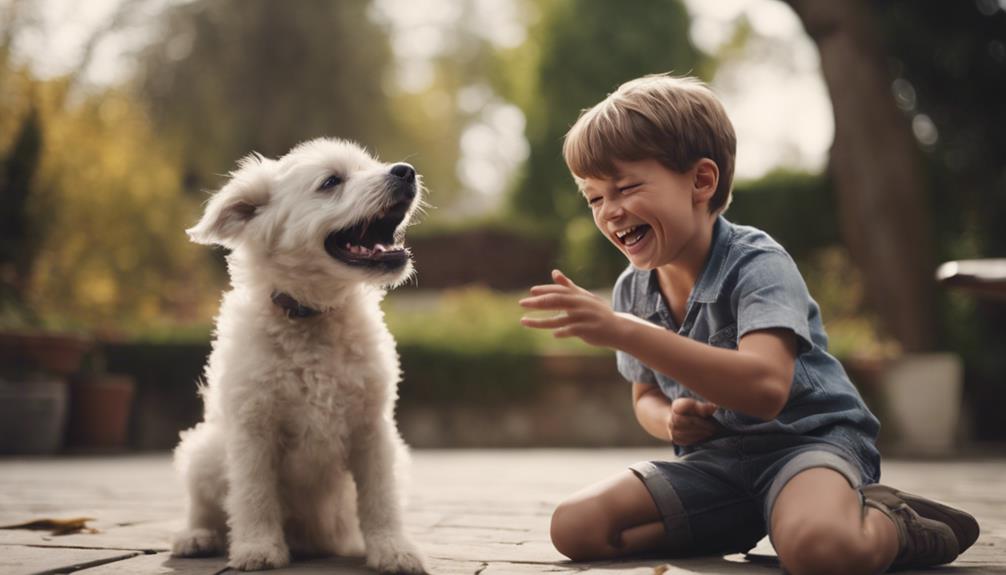
Utilizing positive reinforcement techniques, teaching dogs tricks serves as a valuable means to deepen the connection between children and their canine companions. Teaching dogs tricks not only provides mental stimulation for the dog but also enhances the bond between the child and the pet.
This activity fosters communication, trust, and cooperation between the two, creating a sense of teamwork and accomplishment. Children can take pride in teaching their furry friends new skills, boosting their confidence and sense of responsibility.
Furthermore, the process of teaching tricks encourages physical activity and promotes a positive interaction that strengthens the emotional connection between the child and the dog. Overall, engaging in trick-training sessions can be a fun and effective way to strengthen the relationship between kids and their beloved pets.
Dogs' Influence on Kids' Loneliness
Having a dog in the family has been shown to significantly reduce feelings of loneliness in children. Studies have demonstrated that the presence of a canine companion can provide emotional support and companionship, particularly for kids who may feel isolated or lonely. Dogs offer a non-judgmental presence that can help children feel more secure and less alone. Here is a table highlighting some key ways in which dogs can influence kids' loneliness:
| Ways Dogs Influence Kids' Loneliness | Description | Impact |
|---|---|---|
| Emotional support | Dogs provide comfort and companionship | Helps kids feel less lonely |
| Non-judgmental presence | Dogs offer unconditional love and acceptance | Reduces feelings of isolation |
| Encourages physical activity | Playing with dogs can boost mood and reduce loneliness | Promotes active engagement |
Kids' Responsibilities and Bonding
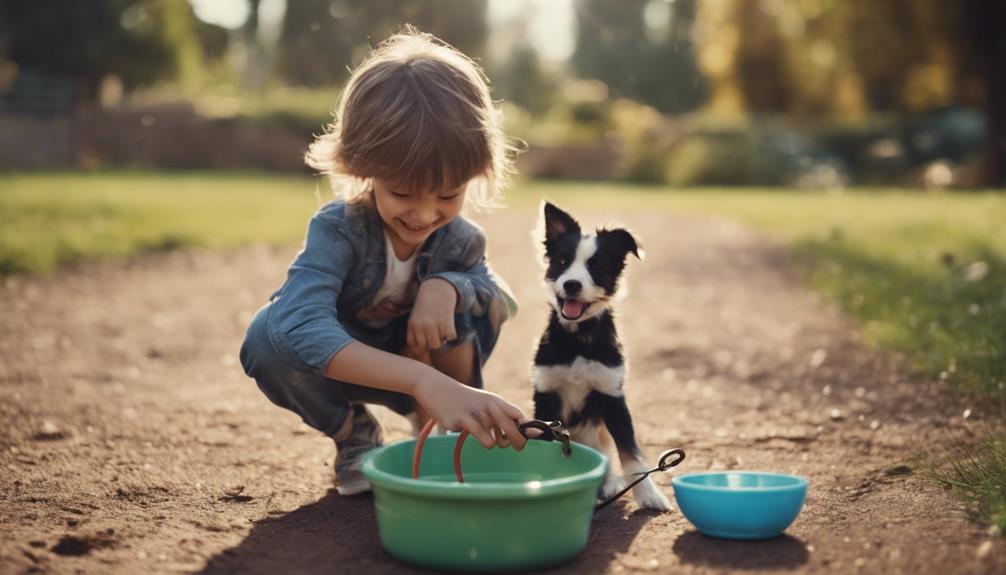
Responsibilities assumed by children in caring for their dogs play a crucial role in fostering a strong bond between the two. When kids take an active role in the care of their canine companions, it not only benefits the dog's well-being but also enhances the relationship between the child and the pet.
Here are four key ways in which kids' responsibilities contribute to bonding with their dogs:
- Feeding: Allowing kids to take charge of feeding their dogs creates a sense of responsibility and care.
- Grooming: Involving children in grooming tasks like brushing or bathing the dog promotes physical interaction and strengthens the bond.
- Training: Teaching kids to train their dogs in basic commands or tricks establishes a sense of leadership and mutual understanding.
- Exercise: Encouraging children to participate in walking or playing with the dog promotes physical activity and shared experiences.
Encouraging Active Lifestyle in Kids
Encouraging children to lead active lifestyles from a young age is crucial for their overall health and well-being. Physical activity not only helps in maintaining a healthy weight but also promotes strong bones, muscles, and mental well-being. Parents can play a significant role in promoting an active lifestyle for their kids by engaging in regular physical activities together. Below is a table highlighting some fun and beneficial activities that families can enjoy to encourage kids to stay active:
| Activity | Description | Benefits |
|---|---|---|
| Family walks | Enjoying nature together as a family | Boosts physical health and bonding |
| Dance parties | Grooving to music at home | Enhances coordination and mood |
| Sports in the park | Playing soccer, frisbee, or catch | Develops teamwork and motor skills |
Strengthening Bond Through Movement
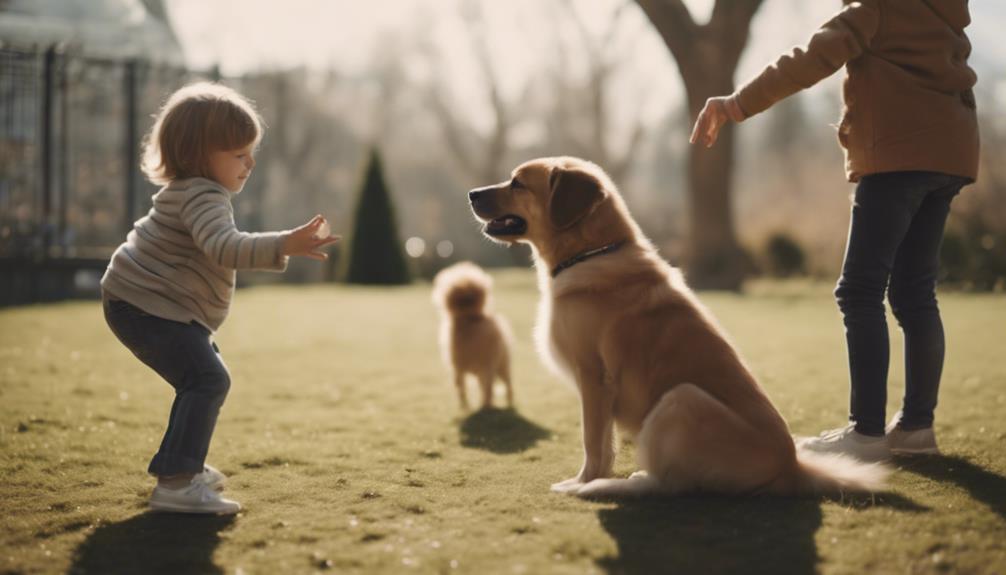
Encouraging physical activity in children not only promotes their overall health but also plays a crucial role in strengthening the bond between kids and dogs through synchronized movements. This shared activity can enhance the connection between the two, fostering mutual understanding and companionship.
To further solidify this bond through movement, consider the following:
- Engage in Playful Activities: Encourage interactive games that involve both the child and the dog, such as fetch or hide-and-seek.
- Take Walks Together: Regular walks provide an opportunity for both the child and the dog to exercise and bond while enjoying the outdoors.
- Practice Obedience Training: Involving the child in teaching the dog basic commands can create a sense of teamwork and cooperation.
- Dance or Move Together: Some children enjoy dancing or moving to music, which can be a fun way to involve the dog in synchronized movements.
Kids Teaching Dogs Enhances Relationship
Teaching dogs new tricks and commands provides children with a valuable opportunity to strengthen the bond and communication between themselves and their canine companions. This interactive process fosters a sense of teamwork and accomplishment for both the child and the dog.
As children engage in teaching their furry friends, they develop patience, empathy, and a deeper understanding of animal behavior. Moreover, the act of teaching a dog tricks can enhance the relationship by building trust and mutual respect.
Through positive reinforcement and consistent training, kids can establish a strong connection with their dogs, creating a harmonious and fulfilling companionship that benefits both the child and the pet in numerous ways.
Science-backed Benefits of Dogs for Kids
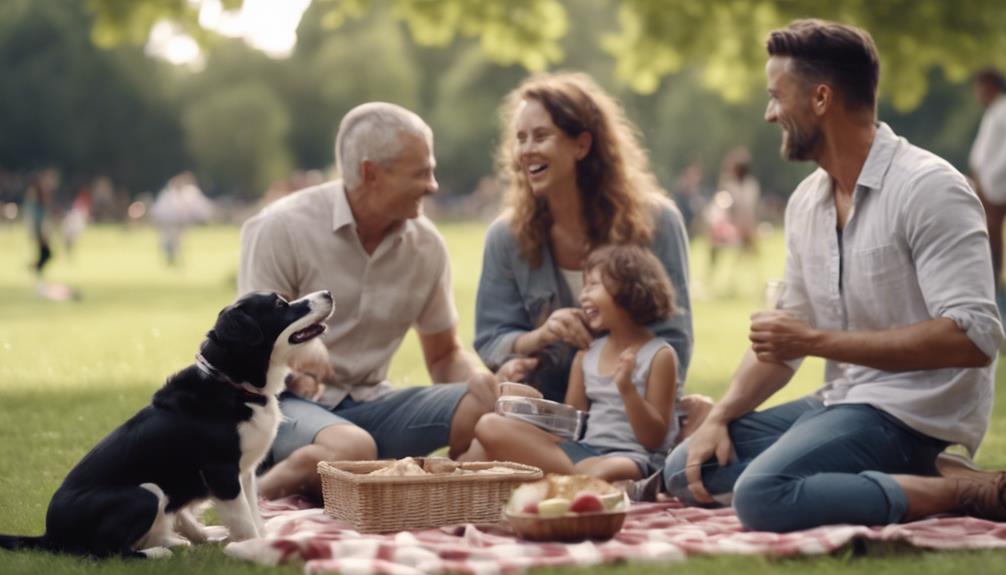
Dogs offer scientifically proven advantages for children, enhancing their well-being and development through unique interactions and companionship. Here are four science-backed benefits of dogs for kids:
- Emotional Support: Dogs can provide comfort and emotional support, helping children cope with stress and anxiety.
- Social Skills: Interacting with dogs can improve children's social skills, empathy, and communication abilities.
- Physical Health: Owning a dog encourages kids to be more active, promoting physical health and overall well-being.
- Responsibility: Caring for a dog teaches children responsibility, time management, and empathy towards others.
Choosing Kid-Friendly Dog Breeds
Selecting a suitable breed of dog that is compatible with children's needs and lifestyle is essential for fostering a harmonious and safe environment within the family. When choosing a kid-friendly dog breed, it is crucial to consider factors such as size, temperament, energy level, and trainability.
Breeds like Labrador Retrievers, Golden Retrievers, Beagles, and Bulldogs are known for their gentle nature and playful disposition, making them great companions for children. Additionally, breeds such as Poodles, Boxers, and Collies are highly trainable and adaptable to various family dynamics.
It is important to research and understand the specific needs and characteristics of different breeds to ensure a successful match between the dog and the children in the household.
Building Strong Bond Through Pet Care
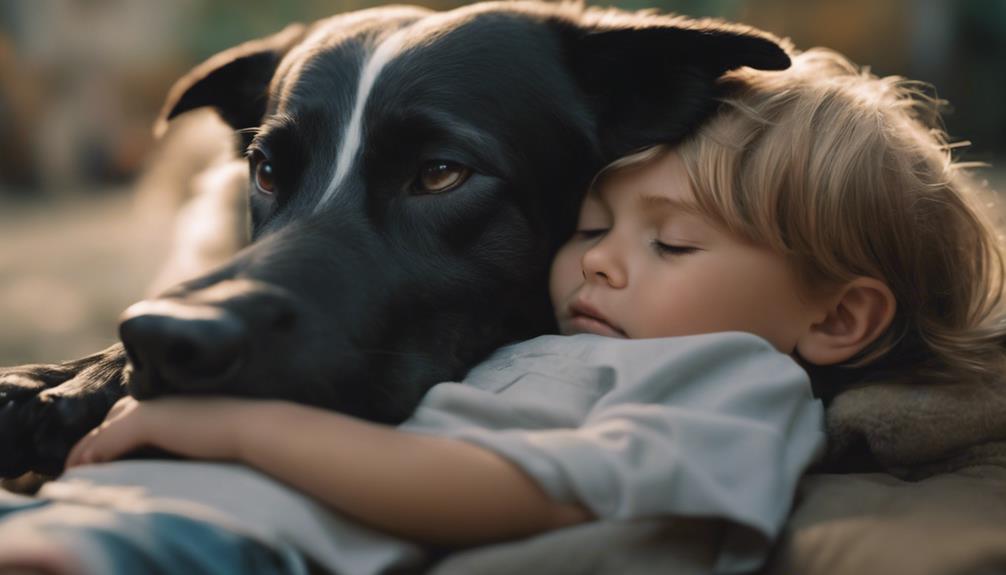
To enhance the relationship between children and their canine companions, fostering a strong bond through responsible pet care practices is paramount. Building a strong bond through pet care involves essential practices that not only benefit the dog but also strengthen the connection between the child and their furry friend. Here are four key ways to achieve this:
- Regular Exercise: Engage in daily walks and play sessions to keep both the child and the dog active and healthy.
- Proper Nutrition: Ensure the dog receives a balanced diet and involve the child in feeding and mealtime routines.
- Grooming and Hygiene: Teach the child to brush the dog, bathe them when needed, and maintain their overall cleanliness.
- Veterinary Care: Schedule regular check-ups and involve the child in vet visits to educate them on the importance of healthcare for their pet.
Enhancing Relationship Through Tricks
Enhancing the bond between children and their canine companions can be further strengthened through engaging in interactive training activities. Teaching dogs tricks can be a fun and rewarding way for kids to connect with their furry friends. Not only does it provide mental stimulation for the dog, but it also fosters a sense of accomplishment for the child. By working together to learn new tricks, both the child and the dog can build trust, communication, and a deeper bond. Here is a table illustrating some easy tricks that kids can teach their dogs:
| Trick | Description | Benefits |
|---|---|---|
| Sit | Dog sits on command | Teaches obedience and listening skills |
| Shake | Dog offers paw for a handshake | Enhances coordination and bonding |
| Roll Over | Dog rolls over on command | Builds trust and strengthens the bond |
Understanding Kids-Dogs Synchrony
Understanding the synchronization between children and dogs is crucial for nurturing a strong and harmonious bond between them. To enhance this connection, consider the following:
- Observing Body Language: Pay attention to how kids and dogs mirror each other's movements.
- Encouraging Positive Interactions: Facilitate playtime and bonding activities to strengthen their relationship.
- Promoting Mutual Respect: Teach children to understand and respect a dog's boundaries and signals.
- Creating a Safe Environment: Ensure that interactions between kids and dogs are supervised to prevent any misunderstandings or accidents.
Conclusion
In conclusion, the study highlights the profound connection between dogs and children, emphasizing the benefits of their synchronized movements and the positive impact of involving kids in the care and training of dogs.
By nurturing this unique bond, children can experience improved well-being, increased self-esteem, and decreased loneliness. Understanding the intricacies of the child-dog relationship is crucial for fostering a strong and lasting connection between these two beings.




